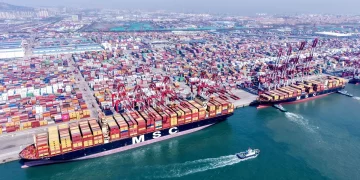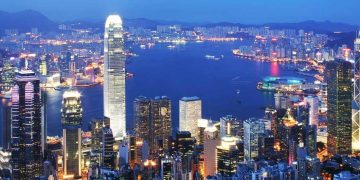Introduction
- Overview of China’s Economic Rise: Provide a background of China’s rise as an economic powerhouse over the last few decades. Discuss how China’s transition from a primarily agrarian economy to an industrial and technological giant has influenced global trade and investment.
- China’s Role in the Global Economy: Explain China’s pivotal role as the world’s second-largest economy and its influence on global markets, including trade, production, and consumer consumption.
- Current Economic Shift: Introduce the topic of China’s economic shift, which includes efforts to transition from an export-driven, manufacturing-heavy economy to a more consumption-based and service-oriented economy.
- The Purpose of the Article: This article seeks to explore the causes of China’s economic shift and assess how it will affect global markets, including the supply chain, international trade, capital flows, and geopolitical dynamics.
Section 1: Understanding China’s Economic Shift
- Background of China’s Economic Model: Discuss the traditional Chinese economic model based on export-driven growth, manufacturing, and heavy investment in infrastructure and real estate.
- The Export-Driven Growth Era: Review the role of exports and manufacturing in China’s economic growth, particularly in the 2000s and early 2010s. Highlight how China became the “world’s factory” and its massive export surplus with countries like the U.S. and Europe.
- Shift to a Consumption-Driven Economy: Explain how China’s leadership has recognized the need for economic rebalancing to reduce reliance on exports and investment, and pivot toward domestic consumption and services.
- The “Dual Circulation” Strategy: Introduce the “dual circulation” strategy, which aims to boost domestic demand while also maintaining an open door for foreign markets.
- China’s New Economic Priorities: Discuss China’s increasing focus on innovation, high-tech industries, green energy, and sustainable growth. Explain the government’s push toward technological self-sufficiency and reducing reliance on foreign markets for key goods like semiconductors.
- Implications of Economic Reforms: Provide a more detailed analysis of the specific reforms China is undertaking in order to reshape its economy, such as encouraging domestic consumption, urbanization, and transitioning to a service-based economy.
- Challenges of the Transition: Address the difficulties China faces in this economic shift, such as rising debt levels, an aging population, and slowing growth rates. Discuss how these challenges may affect China’s overall economic stability and global influence.
Section 2: Impact on Global Trade and Supply Chains
- Changes in China’s Role in Global Trade: Examine how China’s shift away from being the primary exporter of cheap goods to more advanced and value-added products will alter global trade patterns.
- Impact on Global Manufacturing: As China transitions from low-cost manufacturing to higher-value-added industries, countries such as Vietnam, India, and Mexico are positioning themselves to capture some of the manufacturing supply chains that China previously dominated.
- Trade with the U.S. and Europe: Discuss the shifting dynamics of trade between China and its major trading partners, such as the U.S. and Europe. How will China’s reduced emphasis on manufacturing and exports affect trade balances?
- Impact on Global Supply Chains: Explore how China’s changes in manufacturing could lead to shifts in global supply chains, with potential supply disruptions and a reallocation of production to other countries.
- China’s Belt and Road Initiative (BRI): Discuss the impact of the Belt and Road Initiative on global trade, particularly in terms of how China is investing in infrastructure in developing countries to open new markets.
- Expansion of Chinese Influence: Analyze the strategic geopolitical impact of BRI, including how it strengthens China’s influence in Africa, Southeast Asia, and Europe.
- Emerging Markets and Trade Relationships: Explore how emerging markets will be affected by China’s economic shift. In many regions, such as Africa and Latin America, China is a crucial trading partner and source of investment.
- China as a Source of Investment: Discuss the role of Chinese capital in infrastructure development and foreign direct investment (FDI) and how China’s changing economic model may affect future investment flows to these regions.
Section 3: Impact on Global Financial Markets and Capital Flows
- China’s Financial Reforms and Global Capital Flows: Explore how China’s economic shift is likely to affect global financial markets, particularly capital flows, investments, and currency markets.
- China’s Stock Market and Capital Markets: Discuss the role of China’s stock market in global finance, with increased participation from foreign investors. Explore the growth of the Shanghai and Shenzhen stock exchanges and the potential effects of capital market reforms.
- Currency and Exchange Rate Implications: Analyze the impact of China’s economic shift on the renminbi (RMB) and the broader foreign exchange market. How will changes in China’s economy affect the RMB’s internationalization and its role in global trade?
- China’s Efforts to Open Financial Markets: Explore how China’s economic reforms, such as the opening up of its financial markets to foreign investors, are likely to impact the global investment landscape. Discuss China’s stock market linkages to global exchanges, as well as increased participation in global bond markets.
- The Role of Chinese Debt: Analyze the role of Chinese government and corporate debt in global bond markets. China’s growing role as a creditor, particularly through institutions like the Asian Infrastructure Investment Bank (AIIB), may have long-term implications for global capital flows.
- Impact on Commodity Markets: China is the world’s largest consumer of many commodities, including oil, metals, and agricultural products. How will China’s economic shift affect global commodity markets?
- Energy Transition and China’s Role in the Green Economy: As China aims for carbon neutrality by 2060, its shift toward renewable energy will reshape global energy markets, particularly demand for solar, wind, and electric vehicle materials. The changing energy consumption patterns will affect global energy prices and infrastructure investments.
- China’s Influence on Global Agriculture and Manufacturing Inputs: Discuss how China’s demand for agricultural products and raw materials will be impacted by the country’s shift toward high-tech and service-based industries.

Section 4: Geopolitical Implications of China’s Economic Shift
- China’s Global Geopolitical Strategy: Analyze how China’s economic shift will impact its geopolitical strategy, especially in relation to the U.S. and Europe. The transition to a more consumer-driven and innovation-led economy may prompt China to adopt a more assertive foreign policy to safeguard its economic interests.
- U.S.-China Relations: Explore the implications of China’s economic shift for U.S.-China relations, especially in terms of trade wars, tariffs, and strategic rivalry in high-tech industries like semiconductors, artificial intelligence, and 5G technology.
- EU-China Relations: Examine how the European Union will navigate its economic ties with China, especially given Europe’s increasing focus on human rights and environmental sustainability, which could conflict with China’s rise as a technological and industrial superpower.
- China’s Influence on the Global Governance Structure: Consider how China’s economic transformation will affect global institutions such as the International Monetary Fund (IMF), World Bank, and World Trade Organization (WTO). China’s growing economic clout may give it greater influence over the shaping of global financial and trade policies.
- Strategic Competition with the U.S. and Technological Rivalry: Discuss China’s technological ambitions, such as advancements in artificial intelligence, 5G, and quantum computing. How will this technological shift affect global innovation and competition, particularly with the U.S. and other leading tech nations?
Section 5: Risks and Challenges for the Global Economy
- Global Economic Uncertainty: As China transitions to a new economic model, there are risks of economic instability, including potential slowdowns in growth, rising debt levels, and social unrest. These risks can create volatility in global markets.
- China’s Debt and Financial System Risks: Discuss the challenges posed by China’s rising corporate debt and the potential for a financial crisis that could have ripple effects across global markets.
- Impact of Aging Population: China’s aging population may pose significant challenges for its labor force and social security system. This demographic shift could lead to slower growth and affect global investment.
- Impact of China’s Economic Shift on Developed Economies: The article should explore how China’s economic changes will have broader implications for developed economies in the U.S., Europe, and Japan. These regions will need to adapt to the changing trade, investment, and geopolitical landscape driven by China’s economic shift.
Section 6: Conclusion
- Summary of Key Findings: Summarize the key points of the article, including China’s transition to a more consumption-driven economy, the impact on global trade, finance, and geopolitics, and the risks and challenges that come with this shift.
- Outlook for the Global Economy: Provide an analysis of the potential long-term effects of China’s economic shift on global markets, considering various scenarios for growth, stability, and global cooperation.
- Global Cooperation and Strategic Alignment: Conclude by emphasizing the importance of international cooperation and strategic alignment among global powers in managing the transition and ensuring a stable, inclusive economic future.
































